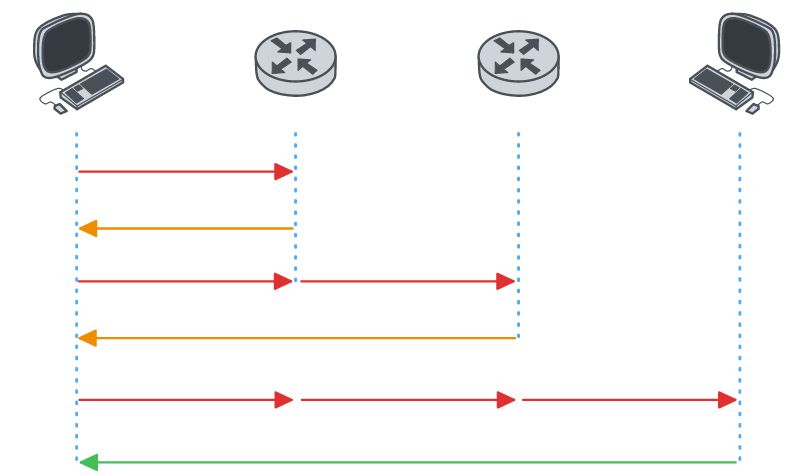3 releases
| 0.1.2 | Jun 18, 2024 |
|---|---|
| 0.1.1 | Jun 17, 2024 |
| 0.1.0 | Jun 16, 2024 |
#11 in #traceroute
41 downloads per month
88KB
2K
SLoC
async-traceroute 

Async Traceroute library/command-line tool.
What is Traceroute
Traceroute allows you to see the path an IP packet takes from one host to another. It uses the TTL (Time To Live) field in the IP packet to elicit an ICMP Time to Live Exceeded message from each router along the path. Each router that handles the packet decreases the TTL field, which effectively acts as a Hop Counter. When a router receives an IP datagram with the TTL field set to 0, it responds with an ICMP Time to Live Exceeded that reveals its IP address.
Several traceroute probe methods exist. This diagram shows how the UDP-based traceroute method works.
Usage
Async Traceroute library/command-line tool
Usage: traceroute [OPTIONS] <HOST>
Arguments:
<HOST>
Options:
-m, --max-hops <MAX_HOPS> Set the max number of hops (max TTL to be reached) [default: 30]
-q, --queries <QUERIES> Set the number of probes per each hop [default: 3]
-w, --wait <WAIT> Wait for a probe no more than <WAIT> [default: 3s]
-N, --sim-queries <SIM_QUERIES> Set the number of probes to be tried simultaneously [default: 16]
-P, --probe-method <PROBE_METHOD> [default: udp] [possible values: udp, tcp, icmp]
-p, --port <PORT> This value changes semantics based on the probe method selected. It is either
initial udp port value for "udp" probe method (incremented by each probe,
default is 33434), or initial seq for "icmp" probe method (incremented as well,
default from 1), or destination port for "tcp" probe method (default is 80)
-n Do not resolve IP addresses to their domain names
-i, --interface <INTERFACE> Specify a network interface to operate with
-h, --help Print help
-V, --version Print version
You can integrate async-traceroute into your project by using it as a library. Here is a code example showing how to
perform a traceroute to google.com:
use futures::pin_mut;
use futures_util::StreamExt;
use async_traceroute::TracerouteBuilder;
use async_traceroute::utils::dns::dns_lookup_first_ipv4_addr;
#[tokio::main]
async fn main() -> Result<(), String> {
let ip_addr = match dns_lookup_first_ipv4_addr("google.com").await {
None => return Err(String::from("Hostname not resolvable")),
Some(ip_addr) => ip_addr,
};
let traceroute = TracerouteBuilder::udp()
.destination_address(ip_addr)
.max_ttl(15)
.queries_per_hop(3)
.max_wait_probe(Duration::from_secs(3))
.simultaneous_queries(16)
.active_dns_lookup(true)
.initial_destination_port(33434)
.network_interface("eth0")
.build();
let traceroute_stream = match traceroute {
Ok(traceroute) => traceroute.trace(),
Err(error) => return Err(error),
};
pin_mut!(traceroute_stream);
while let Some(probe_result) = traceroute_stream.next().await {
println!("{:?}", probe_result);
}
Ok(())
}
Install
Run the following Cargo command in your project directory:
cargo add async-traceroute
Or add the following line to your Cargo.toml:
async-traceroute = "0.1.2"
Docker
Build image:
docker build -t async-traceroute:${VERSION} .
Docker run:
$ docker run async-traceroute:${VERSION} --help
Async Traceroute library/command-line tool
Usage: traceroute [OPTIONS] <HOST>
...
Notes:
- This library requires administrator privileges to create raw sockets
- Tested only on Linux
Todo:
- Add support for Windows
Dependencies
~13–25MB
~396K SLoC
